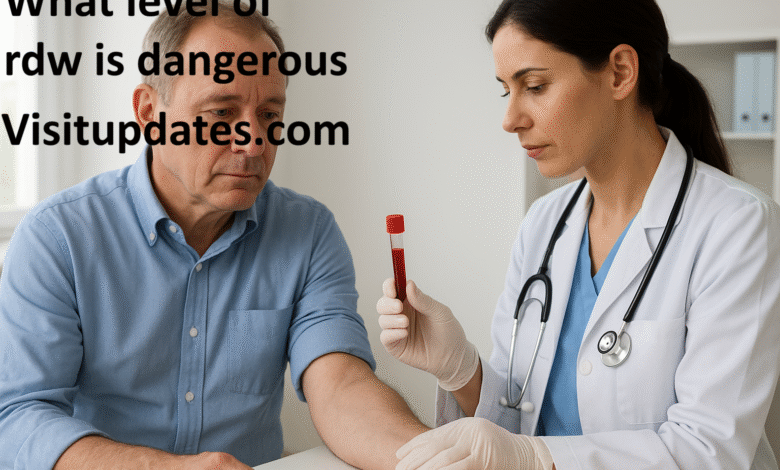What Level of RDW Is Dangerous? Understanding the Warning Signs and Health Risks Explained

If you’ve recently What Level of RDW Is Dangerous received blood test results showing an elevated RDW value, you’re probably wondering what it means and whether you should be concerned. Red Cell Distribution Width, commonly abbreviated as RDW, is a blood test measurement that often flies under the radar but can reveal important information about your health. While it’s not as commonly discussed as cholesterol or blood sugar levels, What Level of RDW Is Dangerous understanding what constitutes a dangerous RDW level could be crucial for early detection of various health conditions. Let’s break down everything you need to know about RDW levels, what’s considered normal, and when those numbers become a red flag for your health.
What Exactly Is RDW and Why Does It Matter?
RDW measures the variation in size of your red blood cells, also known as erythrocytes. Think of it as a way to assess whether your red blood cells are uniform in size or if there’s significant variation among them. The test essentially calculates the difference between the largest and smallest red blood cells in your bloodstream, expressing this as a What Level of RDW Is Dangerous percentage. When your RDW is elevated, it means there’s a greater variation in red blood cell sizes, a condition called anisocytosis.
Your red blood cells play a vital role in carrying oxygen throughout your body. When these cells vary too much in size, it can indicate that something is interfering with normal red blood cell production or that different populations of red blood cells exist simultaneously in your bloodstream. This variation can be an early warning sign of nutritional What Level of RDW Is Dangerous deficiencies, chronic diseases, or blood disorders that require medical attention.
Understanding Normal RDW Levels
The normal RDW range typically falls between 11.5% and 14.5%, though this can vary slightly depending on the laboratory and the testing methods used. Most healthy adults will have RDW values within this range, indicating that their red blood cells are relatively uniform in size. It’s important to note that different labs may have slightly What Level of RDW Is Dangerous different reference ranges, so always compare your results against the specific range provided by your testing facility.
Some factors can naturally influence your RDW levels without indicating disease. Age, for instance, can affect RDW values, with older adults sometimes showing slightly higher readings. Additionally, certain physiological states like pregnancy can temporarily elevate RDW levels. However, consistently elevated readings or values significantly What Level of RDW Is Dangerous above the normal range warrant further investigation and shouldn’t be dismissed as merely age-related or temporary fluctuations.
What Level of RDW Is Considered Dangerous?
While there’s no universally defined “dangerous” RDW threshold, medical professionals generally become concerned when RDW values exceed 15%. Values between 15% and 17% are considered moderately elevated and typically prompt doctors to investigate underlying causes. When RDW climbs above 17%, it’s regarded as significantly What Level of RDW Is Dangerous elevated and often correlates with more serious health conditions or complications.
Research has shown that RDW values above 14.5% are associated with increased mortality risk across various patient populations. Studies involving cardiovascular patients, for instance, have demonstrated that higher RDW levels correlate with worse outcomes and increased risk of complications. In critical care settings, RDW values above 16% have been linked to higher mortality rates and longer hospital stays. However, it’s crucial to What Level of RDW Is Dangerous understand that a high RDW alone doesn’t diagnose a specific condition—it’s a marker that signals the need for further evaluation and testing.
Common Causes of Elevated RDW Levels
Nutritional deficiencies rank among the most common causes of elevated RDW. Iron deficiency, vitamin B12 deficiency, and folate deficiency can all lead to increased red blood cell size variation. These deficiencies interfere with normal red blood cell production, causing the body to release cells of varying sizes into circulation. The good news is that nutritional deficiencies are often correctable through dietary changes or supplementation What Level of RDW Is Dangerous once identified.
Chronic diseases and inflammatory conditions frequently elevate RDW values. Heart disease, kidney disease, liver disease, diabetes, and chronic inflammatory conditions like rheumatoid arthritis or inflammatory bowel disease can all impact red blood cell production and distribution. Blood disorders such as thalassemia, sickle cell disease, and various types of anemia also typically present with elevated RDW. Additionally, certain cancers, particularly those affecting the bone marrow or blood, can significantly increase RDW levels. Chronic alcohol consumption is another factor that can elevate RDW through multiple mechanisms, What Level of RDW Is Dangerous including nutritional deficiencies and direct toxic effects on red blood cell production.
Warning Signs That Accompany Dangerous RDW Levels

High RDW levels What Level of RDW Is Dangerous rarely exist in isolation, and they’re typically accompanied by symptoms related to the underlying condition causing the elevation. Fatigue and weakness are among the most common complaints, as the variation in red blood cell sizes often indicates problems with oxygen delivery to tissues. You might experience shortness of breath, especially during physical activity, or notice that What Level of RDW Is Dangerous you tire more easily than usual.
Other warning signs can include pale skin, dizziness or lightheadedness, rapid heartbeat, cold hands and feet, and brittle nails. Some people report difficulty concentrating or experience mood changes. If you’re dealing with a nutritional deficiency, you might notice additional symptoms like a sore tongue, tingling in the hands or feet, or digestive issues. When elevated RDW is associated with cardiovascular problems, symptoms might include What Level of RDW Is Dangerous chest pain, irregular heartbeat, or swelling in the legs. It’s important to remember that these symptoms aren’t specific to high RDW alone—they reflect the underlying conditions causing the RDW elevation.
The Connection Between RDW and Cardiovascular Risk
Recent medical research has revealed a fascinating connection between elevated RDW and cardiovascular disease risk. Multiple studies have shown that higher RDW values independently predict cardiovascular events, including heart attacks and strokes, even after adjusting for other risk factors. Patients with heart failure who have elevated What Level of RDW Is Dangerous RDW tend to have worse prognoses and higher mortality rates compared to those with normal RDW values.
The mechanism behind this connection isn’t entirely clear, but researchers believe chronic inflammation and oxidative stress play significant roles. These processes affect both cardiovascular health and red blood cell production, creating a relationship between heart disease and RDW elevation. Some experts suggest that elevated RDW might reflect poor overall health status and diminished physiological reserve, making individuals more vulnerable to cardiovascular complications. For people with known heart disease, monitoring RDW alongside What Level of RDW Is Dangerous traditional cardiac markers might provide additional prognostic information.
RDW and Mortality Risk: What the Research Shows
Perhaps most concerning is the growing body of evidence linking elevated RDW to increased mortality risk across various populations. Studies examining hospitalized patients have consistently found that higher RDW values at admission What Level of RDW Is Dangerous predict increased risk of death, regardless of the admission diagnosis. This relationship holds true for patients with heart disease, kidney disease, cancer, and even those admitted for non-medical reasons.
Research involving community-dwelling adults has also demonstrated that elevated RDW predicts all-cause mortality over extended follow-up periods. One large study found that individuals with RDW values in the highest quartile had significantly higher mortality risk compared to those with values in the lowest quartile, even after adjusting for age, sex, and other health factors. While these findings don’t mean that high RDW directly causes death, they suggest that elevated RDW reflects underlying physiological dysfunction that increases vulnerability to various health complications. This makes RDW a potentially valuable marker for assessing overall health status and risk stratification.
When Should You Get Your RDW Tested?
RDW is typically included as part of a complete blood count, one of the most commonly ordered blood tests. Your doctor might order this test during routine health checkups, when investigating symptoms like fatigue or weakness, or when What Level of RDW Is Dangerous monitoring chronic conditions. If you have risk factors for anemia, cardiovascular disease, or inflammatory conditions, regular CBC testing that includes RDW can be valuable for early detection of problems.
You should specifically discuss RDW testing with your healthcare provider if you’re experiencing unexplained fatigue, shortness of breath, dizziness, or other symptoms that might indicate anemia or cardiovascular issues. People with chronic diseases, particularly heart failure, kidney disease, or inflammatory conditions, should have regular monitoring that includes RDW assessment. If you’ve been diagnosed with a nutritional What Level of RDW Is Dangerous deficiency and are undergoing treatment, follow-up testing can help confirm that your treatment is working and your RDW is normalizing.
Steps to Take If Your RDW Is Elevated
Discovering that your RDW is elevated shouldn’t cause panic, but it should prompt action. The first step is working with your healthcare provider to identify the underlying cause. This typically involves reviewing your complete blood count results, looking at other parameters like mean corpuscular volume, hemoglobin, and red blood What Level of RDW Is Dangerous cell count. Your doctor will likely ask about your symptoms, medical history, medications, and lifestyle factors.
Additional testing is usually necessary to pinpoint the cause of elevated RDW. This might include iron studies, vitamin B12 and folate levels, thyroid function tests, inflammatory markers, or more specialized blood tests depending on your clinical presentation. In some cases, imaging studies or referral to a specialist might be warranted. Once the underlying cause is identified, treatment can be targeted appropriately—whether that means iron supplementation for iron deficiency, vitamin B12 injections for pernicious anemia, or What Level of RDW Is Dangerous management of chronic inflammatory conditions.
Lifestyle Changes That May Help Lower RDW
While treating the underlying cause is paramount, certain lifestyle modifications can support healthy red blood cell production and potentially help normalize RDW levels. Ensuring adequate nutrition is crucial, particularly consuming foods rich in iron, vitamin B12, and folate. Iron-rich foods include red meat, poultry, fish, beans, and dark leafy greens. Vitamin B12 is found in animal products like meat, fish, eggs, and dairy, while folate is abundant in leafy vegetables, legumes, and fortified grains.
Limiting alcohol consumption is important, as excessive drinking interferes with red blood cell production and nutrient absorption. If you smoke, quitting can improve overall blood health and reduce inflammation. Managing chronic conditions through medication compliance, regular medical follow-up, and lifestyle modifications appropriate to your specific conditions can help prevent RDW elevation. Regular physical activity, adequate sleep, and stress management also support overall health and may indirectly benefit red blood cell parameters. However, remember that lifestyle changes should complement, not replace, medical treatment for elevated RDW.
The Bottom Line: Understanding Your RDW Results
RDW is more than just another number on your blood test results—it’s a window into your overall health status. While RDW values above 15% warrant attention and further investigation, the specific “danger threshold” depends on various factors including your overall health, other blood test parameters, and clinical context. What matters most isn’t just the number itself, but what it reveals about underlying conditions that may require treatment.
If you discover that your RDW is elevated, don’t ignore it, but also don’t panic. Work closely with your healthcare provider to identify the cause and develop an appropriate treatment plan. With proper diagnosis and management of underlying conditions, many causes of elevated RDW are treatable or manageable. Regular monitoring, adherence to prescribed treatments, and attention to lifestyle factors can help you maintain healthy blood parameters and reduce the health risks associated with elevated RDW. Remember that knowledge is power—understanding what your RDW means puts you in a better position to take charge of your health and work effectively with your medical team to address any concerns.



